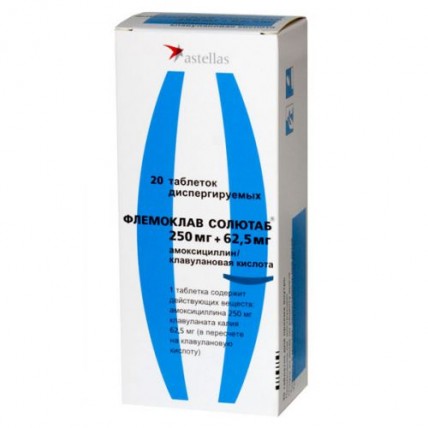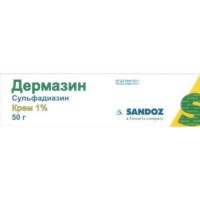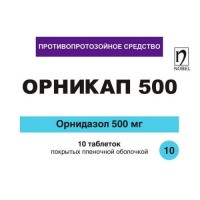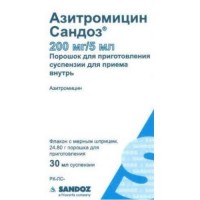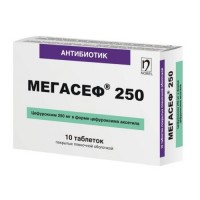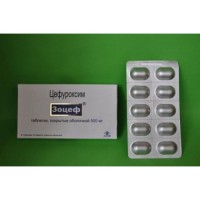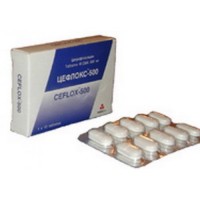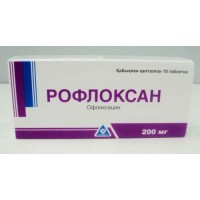Flemoklav Solutab 250 mg / 62.5 mg (20 tablets) dispersing.
- $20.90
Sku:
4841997b48f5
Brand:
astellas (Netherlands)
The instruction for medical use
of Solyutab Flemoklav medicine
the Trade name
of Flemoklav Solyutab
the International unlicensed name
Is not present
the Dosage form
of the Tablet the dispersed 125 mg + 31.25 mg, 250 mg + 62.5 mg, 500 mg + 125 mg
Structure
One tablet contains
active agents:
trihydrate amoxicillin (it is equivalent to amoxicillin)
145.70
(125.00) 291.40 (250.00) 582.80 (500.00)
potassium of the clavulanate diluted (it is equivalent to clavulanic acid) **
37.20
(31.25) 74.50 (62.50) 148.90 (125.00)
excipients: microcrystalline cellulose, krospovidon, vanillin, fragrance apricot, saccharin, magnesium stearate.
The description
of the Tablet of oblong shape, with a biconvex surface, from white till yellow color with dot impregnations of brown color, with marking 421 (for a dosage of 125 mg +31.25 mg), 422 (for a dosage of 250 mg +62.5 mg), 424 (for a dosage of 500 mg +125 mg) and the logo image of firm.
Pharmacotherapeutic group
Beta laktamnye antibacterial drugs.
Penicillin in a combination with inhibitors beta laktamaz.
Clavulanic acid + amoxicillin.
The ATX J01CR02 code
the Pharmacological
Pharmacokinetics Absolute Bioavailability properties of amoxicillin reaches 94%. Absorption does not depend on meal. The maximum concentration in blood plasma is noted in 1-2 hours after intake of amoxicillin. After reception of a single dose 500/125mg (amoxicillin/clavulanic acid) average concentration of amoxicillin (after 8 hours) makes 0.3mg/l. Linking with serum proteins makes about 17-20%. Amoxicillin gets through a placental barrier and in small amounts gets into breast milk.
Amoxicillin is metabolized in a liver (10% of the entered dose), mostly is removed through kidneys (52 ± 15% of a dose in not changed look within 7 hours) and a small amount is removed with bile. Elimination half-life at patients with normal function of kidneys makes about 1 hour (0.9-1.2 h) of blood serum, at patients with clearance of creatinine within 10-30 ml/min. makes 6 hours, and in case of an anury fluctuates in limits between 10 and 15 hours. Drug is removed at a hemodialysis.
The absolute bioavailability of clavulanic acid is about 60%. Absorption does not depend on meal. The maximum concentration in blood of clavulanic acid is noted in 1 – 2 hour after reception. After reception of a single dose of 0.5 g / 125 mg (amoxicillin/clavulanic acid) average maximum concentration of clavulanic acid reaches 0.08 mg/l in 8 hours. Linking with proteins of blood plasma makes 22%. Clavulanic acid gets through a placental barrier. There are no reliable data about penetration into breast milk.
Clavulanate is metabolized in a liver (50-70%) and about 40% are removed through kidneys (18-38% in not changed look). The general clearance is about 260 ml/min. Elimination half-life at patients with normal function of kidneys makes about 1 hour, patients with clearance of creatine have 20 - 70 ml/min. - 2.6 hours, and at an anury – within 3 – 4 hours. Drug is removed at a hemodialysis.
A pharmacodynamics
of Flemoklav Solyutab - an antibiotic of a broad spectrum of activity, the combined drug of amoxicillin and clavulanic acid - inhibitor beta laktamaz. Works bakteritsidno, synthesis of a bacterial wall oppresses. It is active concerning gram-positive and gram-negative microorganisms (including the strains producing beta lactamelements). The clavulanic acid which is a part of drug suppresses II, III, IV and V types beta laktamaz, is inactive concerning the beta laktamaz of the I type produced by Enterobacter spp., Pseudomonas aeruginosa, Serratia spp., Acinetobacter spp. Clavulanic acid possesses a high tropnost to penicillinases, thanks to what forms a stable complex with enzyme that prevents enzymatic degradation of amoxicillin under the influence of a beta laktamaz and expands a range of its action.
Flemoklav shows activity in the relation:
Aerobic gram-positive bacteria: Streptococcus pyogenes, Streptococcus viridans, Streptococcus pneumoniae, Staphylococcus aureus (including the strains producing beta lactamelements), Staphylococcus epidermidis (including the strains producing beta lactamelements), Enterococcus faecalis, Corynebacterium spp., Bacillus anthracis, Listeria monocytogenes
of Anaerobic gram-positive bacteria: Clostridium spp., Peptococcus spp., Peptostreptococcus spp.
Aerobic gram-negative bacteria: Escherichia coli, Klebsiella spp., Proteus mirabilis, Proteus vulgaris, Yersinia enterocolitica, Salmonella spp., Shigella spp., Haemophilus influenzae, Haemophilus ducreyi, Neisseria gonorrhoeae (including the strains of above-mentioned bacteria producing beta lactamelements), Neisseria meningitidis, Bordetella pertussis, Gardnerella vaginalis, Brucella spp., Branhamella catarrhalis, Pasteurella multocida, Campylobacter jejuni, Vibrio cholerae, Moraxella catarrhalis, Helicobacter pylori
of Anaerobic gram-negative bacteria: Bacteroides spp., including Bacteroides fragilis (including the strains producing beta lactamelements).
Indications
- sinusitis, pharyngitis, tonsillitis, acute average otitis, bronchitis, pneumonia
- pyelonephritis, a pyelitis, cystitis, an urethritis, gonorrhea, an endometritis, a cervicitis
- peritonitis, a coloenteritis, a typhoid, a cholangitis, cholecystitis
- the ugly face, impetigo which are again infected a dermatosis
- leptospirosis, listeriosis, a disease Laima (borreliosis), dysentery, salmonellosis, a salmonellonositelstvo
- meningitis
- sepsis
- prevention of an endocarditis
the Route of administration and doses
Inside, to food. The tablet is swallowed entirely, washing down with a glass of water, or dissolve it in half of glass of water (at least 30 ml), carefully stirring before the use.
Duration of treatment depends on weight of an infection and should not without special need exceed 14 days.
To adults and children with body weight more than 40 kg drug appoint on 0.5 g / 125 mg 3 times/days. In heavy, recurrent and persistent infections these doses can be doubled.
For children aged from 3 months up to 2 years (with the body weight about 5-12 kg) the daily dose makes 20-30 mg of amoxicillin and 5-7.5 mg of clavulanic acid on 1 kg of body weight. Usually it makes a dose of 125/31.25 mg 2 times/days. Just before the use to dissolve a tablet in 30 ml of water and to stir carefully.
For children aged from 2 up to 12 years (with the body weight about 13-37 kg) the daily dose makes 20-30 mg of amoxicillin and 5-7.5 mg of clavulanic acid on body weight kg. Usually it makes a dose of 125/31.25 mg 3 times/days for children aged from 2 up to 7 years (body weight about 13-25 kg) and 250/62.5 mg are 3 times/days old for children aged from 7-12 years (body weight about 25-37 kg). In heavy infections these doses can be doubled (the maximum daily dose makes 60 mg of amoxicillin and 15 mg of clavulanic acid on body weight kg).
Patients with impaired renal function
At patients with a renal failure the removal of clavulanic acid and amoxicillin through kidneys is slowed down. Depending on severity of a renal failure the general dose Flemoklava Solyutab (expressed in an amoxicillin dose) should not exceed the following quantities:
Glomerular filtration rate
Adult
Children
of 10-30
ml/min. 0.5 g of 2 times/days
of 15 mg/kg of 2 times/days
& lt, 10
ml/min. 0.5 g in day
of 15 mg/kg a day
the Hemodialysis
of 0.5 g a day and 0.5 g in time and after dialysis
of 15 mg/kg a day and 15 mg/kg in time and after dialysis
Patients with an abnormal liver function
the Combination of amoxicillin/clavulanic acid has to be appointed with care to patients with damages of a liver. Function of a liver has to be under constant control.
Side effects
Very often ≥ 1 of 10, is frequent ≥ 1 of 100 and & lt, 1 of 10, sometimes ≥ 1 of 1000 and & lt, 1 of 100, is rare ≥ 1 of 1000 and & lt, 1 of 1000, also lt is very rare, 1 of 1000
Very often
- diarrhea
Often
- genital candidiasis, candidiasis of skin and mucous covers
- nausea, pains in a stomach
Infrequently
- dizziness, a headache
- dyspepsia, vomiting
- moderate increase in level of liver enzymes of ALT/nuclear heating plant
- skin rash, an itching, a small tortoiseshell
Seldom
- a reversible leukopenia (including a neutropenia), thrombocytopenia
- a multiformny erythema
Very seldom
- a reversible agranulocytosis and hemolytic anemia, increase in a bleeding time and the index of a prothrombin time
- a Quincke's disease, anaphylactic reactions, the syndrome similar to a serum disease, an allergic vasculitis
- reversible hyperactivity and spasms
- the antibiotiko-associated colitis (pseudomembranous and hemorrhagic colitis)
- black hairy language (chronic hyperplasia of threadlike nipples of language)
- Stephens-Johnson's syndrome, a toxic epidermal necrolysis, bullous exfoliative dermatitis, sharp generalized exanthematous pustulez
- intestitsialny nephrite, a crystalluria
- hepatitis, cholestatic jaundice
of the Contraindication
- hypersensitivity to amoxicillin, clavulanic acid or other components
- hypersensitivity to others beta laktamnym to antibiotics, such as penicillin and cephalosporins
- jaundice or dysfunction of a liver at intake of amoxicillin/clavulanate in the anamnesis
- infectious a mononucleosis
- a lymphoid leukosis
- pregnancy and the period of a lactation
- children's age up to 3 months
Medicinal interactions
Antacids, a glycosamine, laxative medicines, aminoglycosides slow down and reduce absorption, ascorbic acid increases absorption Flemoklava.
Bactericidal antibiotics (including aminoglycosides, cephalosporins, Cycloserinum, Vancomycinum, rifampicin) have synergistic actions, bacteriostatic medicines (macroleads, chloramphenicol, linkozamida, tetracyclines, streptocides) - antagonistic.
Flemoklav increases efficiency of indirect anticoagulants (suppressing intestinal microflora, reduces synthesis of vitamin K and the prothrombin ratio). At a concomitant use of anticoagulants it is necessary to watch blood clotting indicators.
Drug reduces efficiency of oral contraceptives, medicines in the course of which metabolism paraaminobenzoic acid is formed that increases risk of developing bleedings of 'break'.
Diuretics, Allopyrinolum, phenylbutazone, the non-steroidal anti-inflammatory drugs and other medicines blocking canalicular secretion increase concentration of amoxicillin (clavulanic acid is removed generally by glomerular filtration).
At joint reception with Allopyrinolum the risk of developing skin rash increases.
Amoxicillin should not be appointed with Disulfiramum.
Simultaneous use of amoxicillin and digoxin can lead to increase in concentration of digoxin in blood plasma.
Special instructions
As well as in case of use of other penicillin of a broad spectrum of activity can arise superinfections of fungal or bacterial genesis (in particular – candidiasis), especially at patients with chronic diseases and/or dysfunctions of the immune system. In case of superinfection the administration of drug is cancelled and/or select suitable therapy.
At patients with renal failures the dose needs to be selected, proceeding from weight of a state.
To patients with abnormal liver functions a combination amoxicillin/clavulanic acid has to be appointed with care and under constant medical control.
Increase in a prothrombin time is seldom noted.
Amoxicillin/clavulanic acid have to be appointed with care to the patients receiving anti-coagulative therapy.
Not fermental methods of definition of sugar of urine and also the urobilinigen test can yield false positive results.
At course treatment it is necessary to carry out control of a condition of function of bodies of a hemopoiesis, a liver and kidneys.
The feature of influence of medicine on ability to run the vehicle or potentially dangerous mechanisms
does not influence.
Overdose
Symptoms: nausea, vomiting and diarrhea with possible disturbance of water and electrolytic balance.
Treatment: activated carbon, support of water and electrolytic balance. In spasms appoint diazepam. In case of a heavy renal failure the hemodialysis has to be carried out.
A form of release and packing
On 4 tablets (for each dosage) in the blister strip packaging from a polyamide and polyvinylchloride film laminated from two parties by aluminum foil and polyurethane adhesive.
On 5 planimetric packs together with the instruction for medical use in the state and Russian languages place in a pack cardboard.
To Store storage conditions at a temperature not higher than 25 wasps.
To store out of children's reach!
3 years
not to use a period of storage after the expiration date specified on packing.
Prescription status
According to the prescription
the Producer Astellas of Pharm B.V. Europe,
Silviusveg 62, 2333 VE, Leiden, Netherlands
the Name and the country of the owner of the registration certificate
Astellas of Pharm B.V. Europe, Silviusveg 62, 2333 VE, Leiden, Netherlands
the Address of the organization accepting in the territory of the Republic of Kazakhstan claims from consumers on quality of products (goods):
Representation Astellas of Pharm B.V. Europe in RK
Almaty, 050559, Al-Farabi Ave. 15, the Centre Party of Finland of Nurla Tau, zd 4B,
office No. 20 Phone number (727) 311-13-89 Fax (727) 311-13-90
www.astellas.ru
to Develop e-mail of astellas@com.kz
of Solyutab Flemoklav medicine
the Trade name
of Flemoklav Solyutab
the International unlicensed name
Is not present
the Dosage form
of the Tablet the dispersed 125 mg + 31.25 mg, 250 mg + 62.5 mg, 500 mg + 125 mg
Structure
One tablet contains
active agents:
trihydrate amoxicillin (it is equivalent to amoxicillin)
145.70
(125.00) 291.40 (250.00) 582.80 (500.00)
potassium of the clavulanate diluted (it is equivalent to clavulanic acid) **
37.20
(31.25) 74.50 (62.50) 148.90 (125.00)
excipients: microcrystalline cellulose, krospovidon, vanillin, fragrance apricot, saccharin, magnesium stearate.
The description
of the Tablet of oblong shape, with a biconvex surface, from white till yellow color with dot impregnations of brown color, with marking 421 (for a dosage of 125 mg +31.25 mg), 422 (for a dosage of 250 mg +62.5 mg), 424 (for a dosage of 500 mg +125 mg) and the logo image of firm.
Pharmacotherapeutic group
Beta laktamnye antibacterial drugs.
Penicillin in a combination with inhibitors beta laktamaz.
Clavulanic acid + amoxicillin.
The ATX J01CR02 code
the Pharmacological
Pharmacokinetics Absolute Bioavailability properties of amoxicillin reaches 94%. Absorption does not depend on meal. The maximum concentration in blood plasma is noted in 1-2 hours after intake of amoxicillin. After reception of a single dose 500/125mg (amoxicillin/clavulanic acid) average concentration of amoxicillin (after 8 hours) makes 0.3mg/l. Linking with serum proteins makes about 17-20%. Amoxicillin gets through a placental barrier and in small amounts gets into breast milk.
Amoxicillin is metabolized in a liver (10% of the entered dose), mostly is removed through kidneys (52 ± 15% of a dose in not changed look within 7 hours) and a small amount is removed with bile. Elimination half-life at patients with normal function of kidneys makes about 1 hour (0.9-1.2 h) of blood serum, at patients with clearance of creatinine within 10-30 ml/min. makes 6 hours, and in case of an anury fluctuates in limits between 10 and 15 hours. Drug is removed at a hemodialysis.
The absolute bioavailability of clavulanic acid is about 60%. Absorption does not depend on meal. The maximum concentration in blood of clavulanic acid is noted in 1 – 2 hour after reception. After reception of a single dose of 0.5 g / 125 mg (amoxicillin/clavulanic acid) average maximum concentration of clavulanic acid reaches 0.08 mg/l in 8 hours. Linking with proteins of blood plasma makes 22%. Clavulanic acid gets through a placental barrier. There are no reliable data about penetration into breast milk.
Clavulanate is metabolized in a liver (50-70%) and about 40% are removed through kidneys (18-38% in not changed look). The general clearance is about 260 ml/min. Elimination half-life at patients with normal function of kidneys makes about 1 hour, patients with clearance of creatine have 20 - 70 ml/min. - 2.6 hours, and at an anury – within 3 – 4 hours. Drug is removed at a hemodialysis.
A pharmacodynamics
of Flemoklav Solyutab - an antibiotic of a broad spectrum of activity, the combined drug of amoxicillin and clavulanic acid - inhibitor beta laktamaz. Works bakteritsidno, synthesis of a bacterial wall oppresses. It is active concerning gram-positive and gram-negative microorganisms (including the strains producing beta lactamelements). The clavulanic acid which is a part of drug suppresses II, III, IV and V types beta laktamaz, is inactive concerning the beta laktamaz of the I type produced by Enterobacter spp., Pseudomonas aeruginosa, Serratia spp., Acinetobacter spp. Clavulanic acid possesses a high tropnost to penicillinases, thanks to what forms a stable complex with enzyme that prevents enzymatic degradation of amoxicillin under the influence of a beta laktamaz and expands a range of its action.
Flemoklav shows activity in the relation:
Aerobic gram-positive bacteria: Streptococcus pyogenes, Streptococcus viridans, Streptococcus pneumoniae, Staphylococcus aureus (including the strains producing beta lactamelements), Staphylococcus epidermidis (including the strains producing beta lactamelements), Enterococcus faecalis, Corynebacterium spp., Bacillus anthracis, Listeria monocytogenes
of Anaerobic gram-positive bacteria: Clostridium spp., Peptococcus spp., Peptostreptococcus spp.
Aerobic gram-negative bacteria: Escherichia coli, Klebsiella spp., Proteus mirabilis, Proteus vulgaris, Yersinia enterocolitica, Salmonella spp., Shigella spp., Haemophilus influenzae, Haemophilus ducreyi, Neisseria gonorrhoeae (including the strains of above-mentioned bacteria producing beta lactamelements), Neisseria meningitidis, Bordetella pertussis, Gardnerella vaginalis, Brucella spp., Branhamella catarrhalis, Pasteurella multocida, Campylobacter jejuni, Vibrio cholerae, Moraxella catarrhalis, Helicobacter pylori
of Anaerobic gram-negative bacteria: Bacteroides spp., including Bacteroides fragilis (including the strains producing beta lactamelements).
Indications
- sinusitis, pharyngitis, tonsillitis, acute average otitis, bronchitis, pneumonia
- pyelonephritis, a pyelitis, cystitis, an urethritis, gonorrhea, an endometritis, a cervicitis
- peritonitis, a coloenteritis, a typhoid, a cholangitis, cholecystitis
- the ugly face, impetigo which are again infected a dermatosis
- leptospirosis, listeriosis, a disease Laima (borreliosis), dysentery, salmonellosis, a salmonellonositelstvo
- meningitis
- sepsis
- prevention of an endocarditis
the Route of administration and doses
Inside, to food. The tablet is swallowed entirely, washing down with a glass of water, or dissolve it in half of glass of water (at least 30 ml), carefully stirring before the use.
Duration of treatment depends on weight of an infection and should not without special need exceed 14 days.
To adults and children with body weight more than 40 kg drug appoint on 0.5 g / 125 mg 3 times/days. In heavy, recurrent and persistent infections these doses can be doubled.
For children aged from 3 months up to 2 years (with the body weight about 5-12 kg) the daily dose makes 20-30 mg of amoxicillin and 5-7.5 mg of clavulanic acid on 1 kg of body weight. Usually it makes a dose of 125/31.25 mg 2 times/days. Just before the use to dissolve a tablet in 30 ml of water and to stir carefully.
For children aged from 2 up to 12 years (with the body weight about 13-37 kg) the daily dose makes 20-30 mg of amoxicillin and 5-7.5 mg of clavulanic acid on body weight kg. Usually it makes a dose of 125/31.25 mg 3 times/days for children aged from 2 up to 7 years (body weight about 13-25 kg) and 250/62.5 mg are 3 times/days old for children aged from 7-12 years (body weight about 25-37 kg). In heavy infections these doses can be doubled (the maximum daily dose makes 60 mg of amoxicillin and 15 mg of clavulanic acid on body weight kg).
Patients with impaired renal function
At patients with a renal failure the removal of clavulanic acid and amoxicillin through kidneys is slowed down. Depending on severity of a renal failure the general dose Flemoklava Solyutab (expressed in an amoxicillin dose) should not exceed the following quantities:
Glomerular filtration rate
Adult
Children
of 10-30
ml/min. 0.5 g of 2 times/days
of 15 mg/kg of 2 times/days
& lt, 10
ml/min. 0.5 g in day
of 15 mg/kg a day
the Hemodialysis
of 0.5 g a day and 0.5 g in time and after dialysis
of 15 mg/kg a day and 15 mg/kg in time and after dialysis
Patients with an abnormal liver function
the Combination of amoxicillin/clavulanic acid has to be appointed with care to patients with damages of a liver. Function of a liver has to be under constant control.
Side effects
Very often ≥ 1 of 10, is frequent ≥ 1 of 100 and & lt, 1 of 10, sometimes ≥ 1 of 1000 and & lt, 1 of 100, is rare ≥ 1 of 1000 and & lt, 1 of 1000, also lt is very rare, 1 of 1000
Very often
- diarrhea
Often
- genital candidiasis, candidiasis of skin and mucous covers
- nausea, pains in a stomach
Infrequently
- dizziness, a headache
- dyspepsia, vomiting
- moderate increase in level of liver enzymes of ALT/nuclear heating plant
- skin rash, an itching, a small tortoiseshell
Seldom
- a reversible leukopenia (including a neutropenia), thrombocytopenia
- a multiformny erythema
Very seldom
- a reversible agranulocytosis and hemolytic anemia, increase in a bleeding time and the index of a prothrombin time
- a Quincke's disease, anaphylactic reactions, the syndrome similar to a serum disease, an allergic vasculitis
- reversible hyperactivity and spasms
- the antibiotiko-associated colitis (pseudomembranous and hemorrhagic colitis)
- black hairy language (chronic hyperplasia of threadlike nipples of language)
- Stephens-Johnson's syndrome, a toxic epidermal necrolysis, bullous exfoliative dermatitis, sharp generalized exanthematous pustulez
- intestitsialny nephrite, a crystalluria
- hepatitis, cholestatic jaundice
of the Contraindication
- hypersensitivity to amoxicillin, clavulanic acid or other components
- hypersensitivity to others beta laktamnym to antibiotics, such as penicillin and cephalosporins
- jaundice or dysfunction of a liver at intake of amoxicillin/clavulanate in the anamnesis
- infectious a mononucleosis
- a lymphoid leukosis
- pregnancy and the period of a lactation
- children's age up to 3 months
Medicinal interactions
Antacids, a glycosamine, laxative medicines, aminoglycosides slow down and reduce absorption, ascorbic acid increases absorption Flemoklava.
Bactericidal antibiotics (including aminoglycosides, cephalosporins, Cycloserinum, Vancomycinum, rifampicin) have synergistic actions, bacteriostatic medicines (macroleads, chloramphenicol, linkozamida, tetracyclines, streptocides) - antagonistic.
Flemoklav increases efficiency of indirect anticoagulants (suppressing intestinal microflora, reduces synthesis of vitamin K and the prothrombin ratio). At a concomitant use of anticoagulants it is necessary to watch blood clotting indicators.
Drug reduces efficiency of oral contraceptives, medicines in the course of which metabolism paraaminobenzoic acid is formed that increases risk of developing bleedings of 'break'.
Diuretics, Allopyrinolum, phenylbutazone, the non-steroidal anti-inflammatory drugs and other medicines blocking canalicular secretion increase concentration of amoxicillin (clavulanic acid is removed generally by glomerular filtration).
At joint reception with Allopyrinolum the risk of developing skin rash increases.
Amoxicillin should not be appointed with Disulfiramum.
Simultaneous use of amoxicillin and digoxin can lead to increase in concentration of digoxin in blood plasma.
Special instructions
As well as in case of use of other penicillin of a broad spectrum of activity can arise superinfections of fungal or bacterial genesis (in particular – candidiasis), especially at patients with chronic diseases and/or dysfunctions of the immune system. In case of superinfection the administration of drug is cancelled and/or select suitable therapy.
At patients with renal failures the dose needs to be selected, proceeding from weight of a state.
To patients with abnormal liver functions a combination amoxicillin/clavulanic acid has to be appointed with care and under constant medical control.
Increase in a prothrombin time is seldom noted.
Amoxicillin/clavulanic acid have to be appointed with care to the patients receiving anti-coagulative therapy.
Not fermental methods of definition of sugar of urine and also the urobilinigen test can yield false positive results.
At course treatment it is necessary to carry out control of a condition of function of bodies of a hemopoiesis, a liver and kidneys.
The feature of influence of medicine on ability to run the vehicle or potentially dangerous mechanisms
does not influence.
Overdose
Symptoms: nausea, vomiting and diarrhea with possible disturbance of water and electrolytic balance.
Treatment: activated carbon, support of water and electrolytic balance. In spasms appoint diazepam. In case of a heavy renal failure the hemodialysis has to be carried out.
A form of release and packing
On 4 tablets (for each dosage) in the blister strip packaging from a polyamide and polyvinylchloride film laminated from two parties by aluminum foil and polyurethane adhesive.
On 5 planimetric packs together with the instruction for medical use in the state and Russian languages place in a pack cardboard.
To Store storage conditions at a temperature not higher than 25 wasps.
To store out of children's reach!
3 years
not to use a period of storage after the expiration date specified on packing.
Prescription status
According to the prescription
the Producer Astellas of Pharm B.V. Europe,
Silviusveg 62, 2333 VE, Leiden, Netherlands
the Name and the country of the owner of the registration certificate
Astellas of Pharm B.V. Europe, Silviusveg 62, 2333 VE, Leiden, Netherlands
the Address of the organization accepting in the territory of the Republic of Kazakhstan claims from consumers on quality of products (goods):
Representation Astellas of Pharm B.V. Europe in RK
Almaty, 050559, Al-Farabi Ave. 15, the Centre Party of Finland of Nurla Tau, zd 4B,
office No. 20 Phone number (727) 311-13-89 Fax (727) 311-13-90
www.astellas.ru
to Develop e-mail of astellas@com.kz
